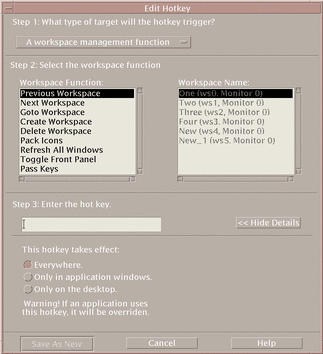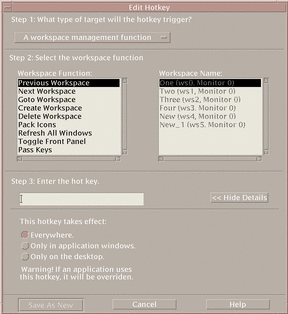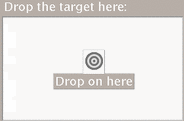Creating a Hotkey
Hotkey Editor does not permit you to create duplicate hotkeys. You can create single letter hotkeys (for example "a") . However, this is not recommended due to the probability of accidentally triggering a target event. Hotkey Editor is not case-sensitive, for example, "A" is the same as "a".
You can create or edit hotkeys to affect the following targets:
-
An application, action, or document
-
A workspace management function
-
A multi-monitor management function
To Create a Hotkey for an Application, Action, or Document
-
From the Hotkey Editor window, click New.

-
For Step 1, from the pull-down menu, select An application, action, document.
-
In Step 2, establish the target that the hotkey will affect.
-
Under Step 3, in the text field, type the keystrokes of your choice that will act as the hotkey.
To determine where the hotkey will be effective, click Show Details.
-
(Optional) Modify where the target event will be active and the path to the target event.
Unless specified the hotkey will be effective everywhere. You can also modify the hotkey's target name or path if no drag and drop option exists for the target.
-
Specify where the hotkey will be active.
-
Everywhere - The created hotkey takes precedence over an application assigned hotkey
-
Only in application windows - The hotkey is effective only in an application window
-
Only on the desktop - Hotkey is effective only on the backdrop of the monitor
-
-
Type the path to the target event that the hotkey will affect.
You may also click Browse to navigate to the target event directory.
-
Enter the command-line argument.
This permits you to have extra command line arguments associated with the target.
-
-
Click Save As New.
-
Click Cancel to close the dialog box.
-
In the main Hotkey Editor window, choose Save from the File menu.
This will activate the hotkey.
Once you have completed creating a hotkey, you can begin creating another new hotkey without exiting the current Edit Key dialog box.
To Create a Hotkey for a Workspace Management Function
-
From the Hotkey Editor window, click New.

-
For Step 1, from the pull-down menu, select A workspace management function.
-
In Step 2, select an option under Workspace Function:
-
Previous Workspace - Moves you to the previous workspace
-
Next Workspace - Moves you to the next workspace
-
Goto Workspace - Moves you to a specified workspace
-
Create Workspace - Creates a new workspace
-
Delete Workspace - Deletes a workspace
-
Pack Icons - Packs the icons in the workspace
-
Refresh All Windows - Updates all windows with any changes you made
-
Toggle Front Panel - Switches the front panel between the open and close state
-
Pass Keys - The defined pass key will override all existing hotkeys. Toggle the pass key hotkey to switch between the on/off modes.
The Workspace Name listbox contains the workspace names as shown on the front panel. It also contains a system identifier in case duplicate names are created. The Workspace Name listbox is enabled only if the workspace function list on the left requires a workspace argument. If you are creating a new hotkey, the first option in the Workspace Function listbox is already selected.
-
-
Under Step 3, in the text field, type the keystrokes of your choice that will act as the hotkey.
To determine where the hotkey will be effective, click Show Details.
-
(Optional) Specify where the hotkey will be active.
-
Everywhere - The created hotkey takes precedence over an application assigned hotkey
-
Only in application windows - The hotkey is effective only in an application window
-
Only on the desktop - Hotkey is effective only on the backdrop of the monitor
-
-
Click Save As New.
-
Click Cancel to close the dialog box.
-
In the main Hotkey Editor window, choose Save from the File menu.
This will activate the hotkey.
Once you have completed creating a hotkey, you can begin creating another new hotkey without exiting the current Edit Key dialog box.
To Create a Hotkey for a Multi-Monitor Management Function
-
From the Hotkey Editor window, click New.

-
For Step 1, from the pull-down menu, select A multi-monitor management function.
-
In Step 2, select an option under Multi-Monitor Function:
-
Next Monitor - Moves to the next monitor
-
Previous Monitor - Moves to the previous monitor
-
Last Monitor - Moves to the last monitor
-
Goto Monitor - Moves to a specified monitor
The Multi-Monitor Function listbox contains the monitor function. The Monitor Number listbox contains a list of monitors available on your desktop.
If you are creating a new hotkey, the first option in the Multi-Monitor Function listbox is already selected.
-
-
Under Step 3, in the text field, type the keystrokes of your choice that will act as the hotkey.
To determine where the hotkey will be active, click Show Details.
-
(Optional) Specify where the hotkey will be active.
-
Everywhere - The created hotkey takes precedence over an application assigned hotkey
-
Only in application windows - The hotkey is effective only in an application window
-
Only on the desktop - Hotkey is effective only on the backdrop of the monitor
-
-
Click Save As New.
-
Click Cancel to close the dialog box.
-
In the main Hotkey Editor window, choose Save from the File menu.
This will activate the hotkey.
Once you have completed creating a hotkey, you can begin creating another new hotkey without exiting the current Edit Key dialog box.
- © 2010, Oracle Corporation and/or its affiliates

